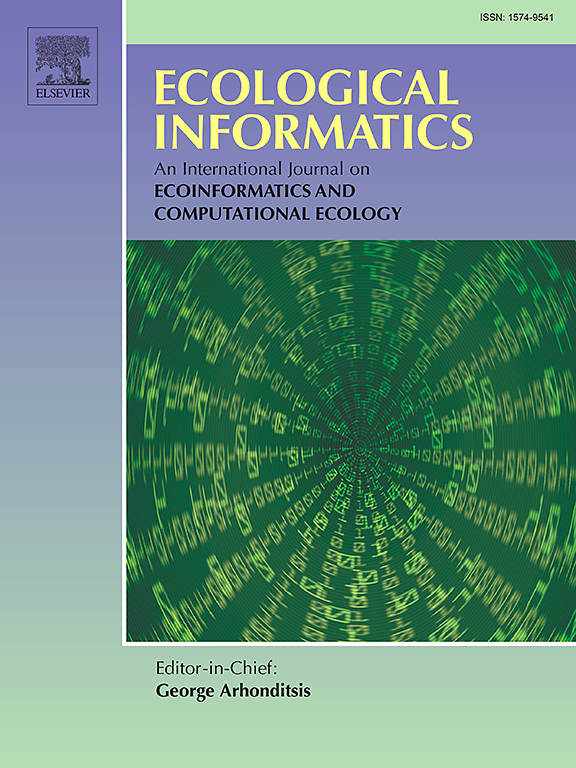Ensemble transfer learning meets explainable AI: A deep learning approach for leaf disease detection
IF 5.8
2区 环境科学与生态学
Q1 ECOLOGY
引用次数: 0
Abstract
Global food security is threatened by plant diseases and manual detection methods are often labor-intensive and time-consuming. Deep learning offers a promising solution by enabling early and accurate detection of leaf diseases. This study presents a novel deep-learning model designed to address the challenges of real-world leaf disease identification. To enhance the model's robustness, we incorporated six datasets (LD, LD1, LD2, LD3, LD4, LD5) which include image augmentation techniques, like flipped versions (LD1) and controlled noise (LD2, LD3). Additionally, we introduced new datasets with additional noise types (LD4) and real-world scenarios (LD5). To further improve accuracy, we employed an ensemble approach, combining MobileNetV3_Small and EfficientNetV2B3 with weighted voting. Our model achieved exceptional performance, surpassing 94 % accuracy on imbalanced data (LD) and exceeding 99 % on balanced, high-quality data (LD1). Even in noisy environments (LD2, LD3, LD4, LD5), our model consistently outperformed other approaches, maintaining an accuracy rate above 90 %. To ensure transparency and interpretability, we utilized Explainable AI (LIME) to visualize the model's decision-making process. These results demonstrate the potential of our model as a reliable and accurate tool for leaf disease detection in practical agricultural settings.
集成迁移学习与可解释的人工智能:叶片病害检测的深度学习方法
全球粮食安全受到植物病害的威胁,人工检测方法往往是劳动密集型和耗时的。深度学习提供了一个有前途的解决方案,使早期和准确的检测叶片疾病。本研究提出了一种新的深度学习模型,旨在解决现实世界叶片疾病鉴定的挑战。为了增强模型的鲁棒性,我们纳入了六个数据集(LD, LD1, LD2, LD3, LD4, LD5),其中包括图像增强技术,如翻转版本(LD1)和控制噪声(LD2, LD3)。此外,我们引入了具有额外噪声类型(LD4)和真实场景(LD5)的新数据集。为了进一步提高准确性,我们采用了一种集成方法,将MobileNetV3_Small和EfficientNetV2B3与加权投票相结合。我们的模型取得了优异的性能,在不平衡数据(LD)上的准确率超过94%,在平衡、高质量数据(LD1)上的准确率超过99%。即使在嘈杂的环境中(LD2、LD3、LD4、LD5),我们的模型也始终优于其他方法,准确率保持在90%以上。为了确保透明度和可解释性,我们使用了可解释人工智能(LIME)来可视化模型的决策过程。这些结果证明了我们的模型在实际农业环境中作为可靠和准确的叶片病害检测工具的潜力。
本文章由计算机程序翻译,如有差异,请以英文原文为准。
求助全文
约1分钟内获得全文
求助全文
来源期刊

Ecological Informatics
环境科学-生态学
CiteScore
8.30
自引率
11.80%
发文量
346
审稿时长
46 days
期刊介绍:
The journal Ecological Informatics is devoted to the publication of high quality, peer-reviewed articles on all aspects of computational ecology, data science and biogeography. The scope of the journal takes into account the data-intensive nature of ecology, the growing capacity of information technology to access, harness and leverage complex data as well as the critical need for informing sustainable management in view of global environmental and climate change.
The nature of the journal is interdisciplinary at the crossover between ecology and informatics. It focuses on novel concepts and techniques for image- and genome-based monitoring and interpretation, sensor- and multimedia-based data acquisition, internet-based data archiving and sharing, data assimilation, modelling and prediction of ecological data.
 求助内容:
求助内容: 应助结果提醒方式:
应助结果提醒方式:


